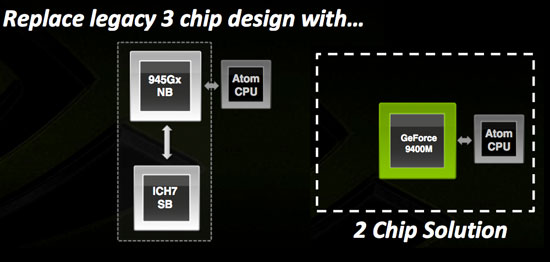NVIDIA's Ion Platform: Bringing High Def to Netbooks
by Anand Lal Shimpi on December 17, 2008 9:00 AM EST- Posted in
- GPUs
Intel has been shipping its Atom processor for months now, although it has been talking about the CPU for much longer. Earlier this year I went through the architecture and unique design approach behind Intel’s first foray into a new approach to chip design since the original Centrino.
While Atom isn’t setting any performance records, it is amazingly powerful for its size and power consumption. In making Atom, Intel made sure to give it an equally impressive chipset: Poulsbo. The combination of Atom and Poulsbo unfortunately uses too much power and is too big to be used in the most attractive of devices: smart phones, relegating them to MIDs (Mobile Internet Devices). MIDs aren’t terribly successful, mostly because they are bulky, plagued by terrible UIs and too expensive for what they are. In a couple of years Atom will surely find its way into smart phones thanks to Intel’s push for integration, but thanks to the Netbook segment Atom hasn’t gone unappreciated.
Largely pioneered by the efforts of ASUS and obsession with the letter E, the Netbook market is almost entirely dominated by Intel’s Atom CPU. In order to keep costs down, Netbook manufacturers have paired Atom with a desktop chipset instead of Poulsbo: the Intel 945G. Since Atom’s FSB can work in GTL+ mode, it is compatible with Pentium 4/Core 2 chipsets.
Atom is honestly fast enough for many tasks, delivering the performance of a mainstream notebook from 4 years ago. The problem is that there are some applications that are commonplace today that can’t run on Atom. HD video playback isn’t possible on Atom + 945G platforms because the CPU isn’t fast enough to decode high bitrate video (much less H.264) and the chipset doesn’t support HD video decode acceleration.
NVIDIA saw an opportunity with Atom. Intel had a very popular CPU, that could be used in many more environments if it could only be paired with a more powerful chipset. Enter the GeForce 9400M.

This is the same GeForce 9400M that’s used in desktops and notebooks, the very same GeForce 9400M that’s in the new MacBook, MacBook Pro and MacBook Air...and NVIDIA is pairing it up with Intel’s Atom processor.

















61 Comments
View All Comments
MadMan007 - Wednesday, December 17, 2008 - link
Reply to both above: yes, I'm sure the OEMs would come up with a HDD+optical solution. This just would have been a no-go if it only had one SATA overall. Hopefully DIY solutions would have two internal SATA ports, however they're implemented (main motherboard or picoITX board.)strikeback03 - Wednesday, December 17, 2008 - link
I'd imagine that all the eSATA, additional USB, sound, etc is provided by additional chips on that larger board.Thorburn - Wednesday, December 17, 2008 - link
I don't believe Netbooks tend to use Poulsbo. This is the chipset used for MID devices (and the Dell Mini 12 I believe), and I think it supports some H.264 decoding (baseline 720p?). It is paired up with Silverthorne Atom CPUs (Z-series) which I don't think support GTL+ front-side bus due to its higher power requirements.Most Netbooks use the Diamondville Atom CPUs (N-series), which have a slightly higher TDP, support GTL+ and are paired with the older, higher power, 945GC chipset.
R3MF - Wednesday, December 17, 2008 - link
finally the netbook becomes a useful computing device with the addition of CUDA/OpenCL.i say this as the owner of a Lenovo S10e.
djc208 - Wednesday, December 17, 2008 - link
This could be the device that finally makes me consider building a carPC.And while the Sage HD extender and Popcorn hour are great for video playback, the added functionality of a full PC in this form factor could make it a winner for HD capable HTPC client machines.
strikeback03 - Wednesday, December 17, 2008 - link
Will this be cheaper than using the Poulsbo chipset? As none of the netbooks seem to be willing to offer Poulsbo for an increased cost, will the 9400M be cheap enough to get some business?Looks great for a carputer though.
superunknown98 - Wednesday, December 17, 2008 - link
How I would have like a NANO in this. Seeing as how even with a Nvidia mobile 9600 the Atom can't play half-life 2. Just look at the Asus N10Jc-A1 netbook. So again what happened to the platform Nvidia said they were designing for the Nano? Did Via just get played?UNHchabo - Wednesday, December 17, 2008 - link
Keep in mind that HL2 (and Source engine games in general) are pretty CPU-intensive, with much less emphasis on the GPU than other engines, like those made by Ubisoft, id, and others.I'm pretty sure one of these two articles investigates that, but I can't check at the moment...
http://www.anandtech.com/video/showdoc.aspx?i=2278">http://www.anandtech.com/video/showdoc.aspx?i=2278
http://www.anandtech.com/video/showdoc.aspx?i=2281">http://www.anandtech.com/video/showdoc.aspx?i=2281
SkullOne - Wednesday, December 17, 2008 - link
Wow...very very nice. I say increase the size just a little bit, add a slim BluRay player and kick the MacMini between the eyes!!!crimson117 - Wednesday, December 17, 2008 - link
I bet this will drive the next Mac Mini revision.